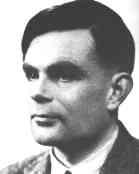Short biography of
Alan Turing

Alan Mathison
Turing was born June 23, 1912 in a nursing home in Paddington, London to
Julius Mathison and Ethel Sara Turing. His father Julius, an officer in
the British administration in India , decided that his son would be raised
in England.
Alan Turing
and his older brother John had a childhood ridigly determined by the demands
of the class and the exile in India of his parents. Alan and his brother
were shuffled amongst various English foster homes as children until their
father retired from India in 1926. Alan was niether encouraged nor supported
in the foster homes and through his own pursuits found a deep underlying
passion for science, first in chemistry experiments.
As Alan became more enticed with science his mother worried that he would
not be accepted into Sherbourne,the English Public School. However, in
1926 Alan was granted admission into Sherbourne and his mother's fears
were dissolved for a short while. Soon after his admission the Headmaster
soon reported :"If he is to be solely a scientific specialist, he is wasting
his time at a public school." In hindsight, we might say this Headmaster's
assessment was almost correct. Many other teachers also made similar remarks.
In 1928, Turing began to study relativity. It was at this time, on the
sixth form that Alan met Christopher Morcom; and everything changed. However,
when his good friend Christopher Morcom died in 1930, Turing was devastated,
but at the same this motivated him to do what Morcom could not.
For a couple of years following the death Alan wrote letters to Morcom's
mother questioning how the human mind , and Christopher's mind in particular,
was embodied in matter; and whether this matter was released after death.
This questioning led him to study twentieth century physics where Turing
began to wonder whether quantum mechanical theory affected his questions
of mind and matter.
On a visit to the Morcom home Turing wrote a letter stating his belief
in the survival of the spirit after death.
In 1931, Turing won a entrance scholarship at King's college in Cambridge.
Attending there as an undergraduate from 1931, Turing was encouraged to
express his ideas freely. In 1932 Turing read Vol Neuman's work on the
logical foundations of Quantum mechanics. It was here, at King's, that
homosexaulity became a distinctive part of ihs identity. He befriended
a fellow undergraduate mathematician named James Atkins, who later became
his lover. For relaxation, Alan enjoyed rowing, running and later sailing.
Turing was doing exceptionally well. He recieved his degree in 1934 followed
by a M.A. degree from King's College in 1935, and a Smith's prize in 1936
for the work on probability theory. Turing became very interested in the
problem of computability. He wanted to find out what a computation is and
whether a computation can in fact be carried out. To answer these questions
Turing extracted from the ordinary process of computation the essential
parts and formulated these in terms of a theoretical machine, known as
theTurning machine. It has been speculated that Turing found in the concept
of the Turing machine something that satisfied the problem of the mind
brought on by Chistopher Morcom. He expanded this idea to show that there
exists auniversal Turning machine, a machine which can calculate any number
and function, given the appropriate instructions.
In September, 1936 Turing enrolled as a graduate student at Princeton University.
His Paper, On Computable Numbers..was published near the end of 1936.This
paper generated a lot of attention for him and the idea came to mathematician
John Von Neumann. Turing obtained his Ph.D thesis through work that extended
his original ideas (Ordinal Logic).
Returning to England and King's College in 1938, he was called on the outbreak
of World War II, to serve at the Government Code and Cypher School in Bletchley
Park in Buckinghamshire. It was there that Turing led in the successful
effort to crack the the German "Enigma" code, an effort which was central
in the defeat of Nazi Germany.
After the war, Turing joined the National Physical Laboratory
to work on the design of a computer.He continued his work at the University
of Manchester after 1948. Turing's promising career came to a grinding
halt when he was arrested in 1952 for "gross indecency". The penalty for
this crime was submission to psychoanalysis and to horrible treatments
designed to "cure" the disease. Unfortunately, the cure proved worse than
the disease, and in a fit of depression, Turing committed suicide in June
of 1954 by eating a cyanide-poisoned apple.